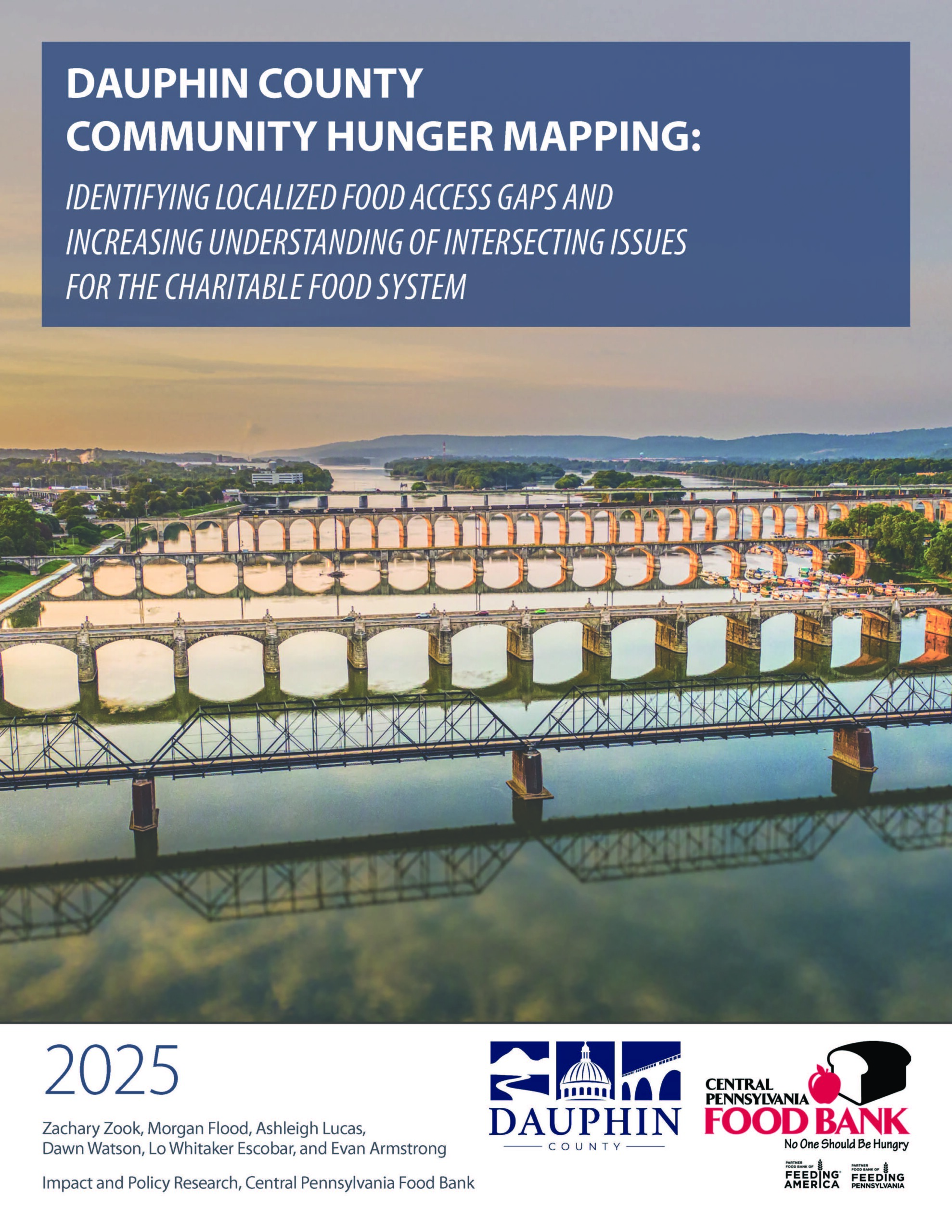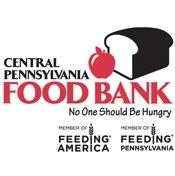Dauphin County
Community Hunger Mapping
Community Hunger Mapping
More than 32,000 residents of Dauphin County face food insecurity as of Feeding America’s most recent Map the Meal Gap estimates. Of these food insecure residents, two in five are children, and one in three lives within Harrisburg city limits. The burden of not knowing from where the next meal will come weighs upon every neighborhood and municipality across the county; however, this burden is unevenly spread across the county and its citizens depending on demographics, geography, and a host of other factors.
This Community Hunger Mapping report seeks to more deeply understand the dispersion, experience, and root causes of food insecurity across and within Dauphin County in a detailed, nuanced, and compassionate manner. To depict the landscape of food insecurity and the charitable food network’s response to it, this report centers the thoughts of neighbors experiencing food insecurity as gathered through surveys conducted at food pantries and other community resources throughout the county as well as one-on-one interviews. As part of a unique analysis designed for this report, several interviews were conducted on site at soup kitchens to better understand the experiences of unhoused individuals who interact with the charitable food system.
The views of charitable food providers are also included via surveys and listening sessions, and for the first time in a Community Hunger Mapping project, Central Pennsylvania Food Bank (CPFB) researchers visited every pantry in the county to collect observational data about their physical and emotional environments. Quantitative analyses of public and privately available data also appear throughout this report to provide crucial perspective. This comprehensive, mixed-methods approach to the project makes it the most vibrant, complete portrait of a local charitable food network to date.
Considering the scale and complexity of food insecurity within Dauphin County, those who wish to address and alleviate it must gain deep insight into its reality, but insight is not enough to create change on its own. This report makes specific, actionable recommendations to improve the experiences of food insecure neighbors in the short term and to end hunger in the longer term.
Implementing the recommendations in this report and creating change will require intentional, sustained, collaborative work by a wide variety of stakeholders within Dauphin County, including food bank and pantry leaders, municipal, county, and state governments, anti-poverty social service organizations, healthcare providers, concerned citizens, and many more. Throughout this collective effort, the charitable food network supporting Dauphin County’s most vulnerable citizens will build on its existing strengths while addressing inequities and seeking the continuous improvement needed to build a future where no one goes hungry.
View An Interactive Copy of the Full Report Below
or CLICK HERE to Download
Avenue One – Charitable Food System
Key Finding 1: The charitable food system in Dauphin County reduces very low food security through each visit neighbors make to pantries, with a greater difference made among those who visit more often.
Very low food security drops from 63% among pantry visitors who visit once every three months or less (4 times or fewer in the last year), to just 37% among pantry visitors who visit around 2 times per month or more on average (20 times or more in the last year).
This finding represents the most important strength of the charitable food system because it shows that despite all the challenges facing the charitable food system in Dauphin County, pantry providers reduce hunger meaningfully among pantry visitors.
Key Finding 2: The Dauphin County charitable food system has many strengths, including excellent geographic access to pantries, robust pantry opening hours (including evenings and weekends), and strong access to choice pantries in most of the county.
While there is always room for improvement in these areas and others, Dauphin County starts from a position of strength in many major access dimensions.
Key Finding 3: There are several large opportunities for growth in the Dauphin County charitable food network; many of these revolve around less tangible elements of the pantry environment such as the neighbor experience and pantry adherence to compliance guidelines.
There is also opportunity to make more concrete adjustments such as diversifying food offerings and investing in pantry capacity.
Key Finding 4: Staff and volunteers are critical to the operation of the charitable food system, and interactions between staff/volunteers and pantry visitor neighbors are largely positive. Unfortunately, there are also many negative interactions reported by neighbors at pantries and these unpleasant experiences can make people less willing to seek help.
Feelings of judgment at pantries in Dauphin County averaged 7%, which is higher than in other counties where surveys have been completed. Neighbor treatment issues and conflict were severe at times in some Dauphin County pantry locations. Strategies to help pantries provide a high level of service include requiring pantry workers to attend trauma-informed care training, taking care to place volunteers and staff in roles in which they can succeed, and working to offer translated resources or have multilingual volunteers. Pantries should also work to reduce potential pain points that may arise from complicated intake practices and be worsened by inconsistent or inaccurate adherence to compliance standards.
Key Finding 5: Many pantries have a wide variety of restrictions for neighbors that go beyond allowable practices from the USDA and Pennsylvania Department of Agriculture, including strict documentation requirements for neighbors such as presenting photo IDs (required by 52% of pantries) or proof of residence like utility bills (required by 44% of pantries) at the point of service.
Other non-compliant restrictions include refusing service to those who reside outside of a service territory and preventing caretakers from bringing children into the pantry.
Pantries across the county must ensure their practices are consistent with food bank and government program compliance standards not only because they are required to do so, but also because doing so increases the ability of charitable food providers to reduce very low food security. There are no requirements to receive government-supported pantry services other than a completed self-declaration of need form. All other document requirements must be optional. Additionally, children must be allowed to accompany their caretakers into pantries. This is of particular importance in Dauphin County as households with children are disproportionately likely to face food insecurity and make up around half of all pantry visitors.
Key Finding 6: Food pantries across Dauphin County report struggling with insufficient resources, in terms of both funds and volunteers to serve neighbors.
Nearly two thirds of pantries reported funding as their biggest issue, and neighbors noted that their pantries work hard to provide high-quality services despite facing many constraints. One neighbor shared, “The only thing I ask is that… If they can receive more things to be able to help us with, then they would have more to give us.” Pantries do all they can with limited capacity and funds, but they need more support; increasing pantries’ access to support will take concerted effort from all the county’s stakeholders. State and federal programs, such as the State Food Purchase Program (SFPP) and The Emergency Food Assistance Program (TEFAP), have not kept up with increased demand for food pantries, further stressing strained food pantry budgets.
Volunteers are another critical piece of the charitable food system, but many pantries report not having enough to operate fully, let alone expand hours or availability. Volunteering is one of the most important ways community members can participate in the charitable food network, but volunteers and pantries finding each other is a challenge. The creation of a centralized volunteer portal could potentially provide a low-friction way for interested members of the public and pantries in search of volunteers to match with one another.
Avenue Two – Increasing Participation in Key Government Programs
Key Finding 1: Dauphin County overall has very strong participation in many government programs, especially SNAP, for which it has the second highest participation rate in Pennsylvania. However, there is still room for growth.
The best-targeted opportunities for additional program outreach lie with WIC, school meals, and summer meal programs for kids.
Key Finding 2: WIC is a critical tool that can be used to support the populations most vulnerable to very low food security, but more outreach is needed, particularly in ZIP Codes 17104, 17109, and 17103 in the Harrisburg area.
WIC reduces very low food security by more than 20% among participating pantry visitors, but less than a third (32%) do so. Rates are especially low among Hispanic households at just 24%.
The largest WIC gaps by ZIP code in the county are all in Harrisburg or its immediate suburbs; 17104 alone accounts for nearly 40% of the county’s WIC gap and is one of the largest in the state.
Key Finding 3: Dauphin County schools have strong participation in meal programs, but there are more than 20 schools that have breakfast participation rates at or below 25%, despite it being universally free to all students. Most of these are middle and high schools.
Research shows that alternative breakfast models are effective ways to increase breakfast uptake, but they are underutilized at these schools.
Key Finding 4: Food insecure children are especially vulnerable in the summertime, when school is closed and school meals are not available. SUN Meal programs exist to fill this gap, but access to sites is limited in parts of Dauphin County.
Areas of opportunity include placing traditional congregate meal sites Steelton-Highspire School District and parts of Lower Dauphin School District and offering rural non-congregate services in much of northern Dauphin.
Avenue Three – Intersecting and Upstream Issues
Key Finding 1: Income is the most important determinant of food security status nationally and among pantry visitors in Dauphin County, with the primary issues being low wages, irregular work, and the inadequacy of benefits rather than unemployment.
Most pantry visitors who can work, do work, but over half of all full-time workers report earning less than the poverty level for their household size. For most workers, a poverty-level threshold works out to wages of $11.50 an hour or less. Disability is one of the biggest risk factors for food insecurity, both for households receiving Disability or SSI and for those who report disability as the main barrier to work but do not receive benefits.
Key Finding 2: Housing and housing-related expenses like utilities are the number one tradeoff with food reported by pantry visitors. Forced moves are also a major issue that disproportionately affects Black and Hispanic households, especially those living in the city of Harrisburg.
Around a third (31%) of pantry visitors in Harrisburg are worried about a forced move and 14% have experienced one. These are the highest rates of forced moves found in any county where Community Hunger Mapping has been completed. Forced moves have a strong association with very low food security status, as two thirds of households who have experienced are worried about a forced move also experience very low food security.
Key Finding 3: Unhoused households in Harrisburg report that food is accessible to them via a number of providers across the city and that these providers treat them with dignity and respect, but they still assume a variety of risks when accessing these resources.
Housing precarity, defined as living situations that are doubled-up, sleeping rough, or in a shelter, is one of the most direct determinants of very low food security status, with households in precarious housing situations facing very low food security rates of 57% compared to 41% overall. Safe, stable, affordable housing is critically important to making measurable progress to reducing very low food security among unhoused and precariously housed households.
Key Finding 4: Vehicle access is one of the most common barriers to both pantry access and employment cited by pantry visitors in Dauphin County, with more than half of pantry visitors in Harrisburg reporting a primary means of transportation other than a car.
Many report difficulty accessing employment opportunities as a result.
Key Finding 5: Half of all food pantry visitor households have at least one individual facing a chronic health condition, with 45% of pantry visitor households managing high blood pressure or diabetes.
The charitable food system should continue to strengthen its partnerships with health providers across Dauphin County, as food insecurity and health have intersecting and additive interactions.
Interactive Map of Food Insecurity in
Dauphin County


